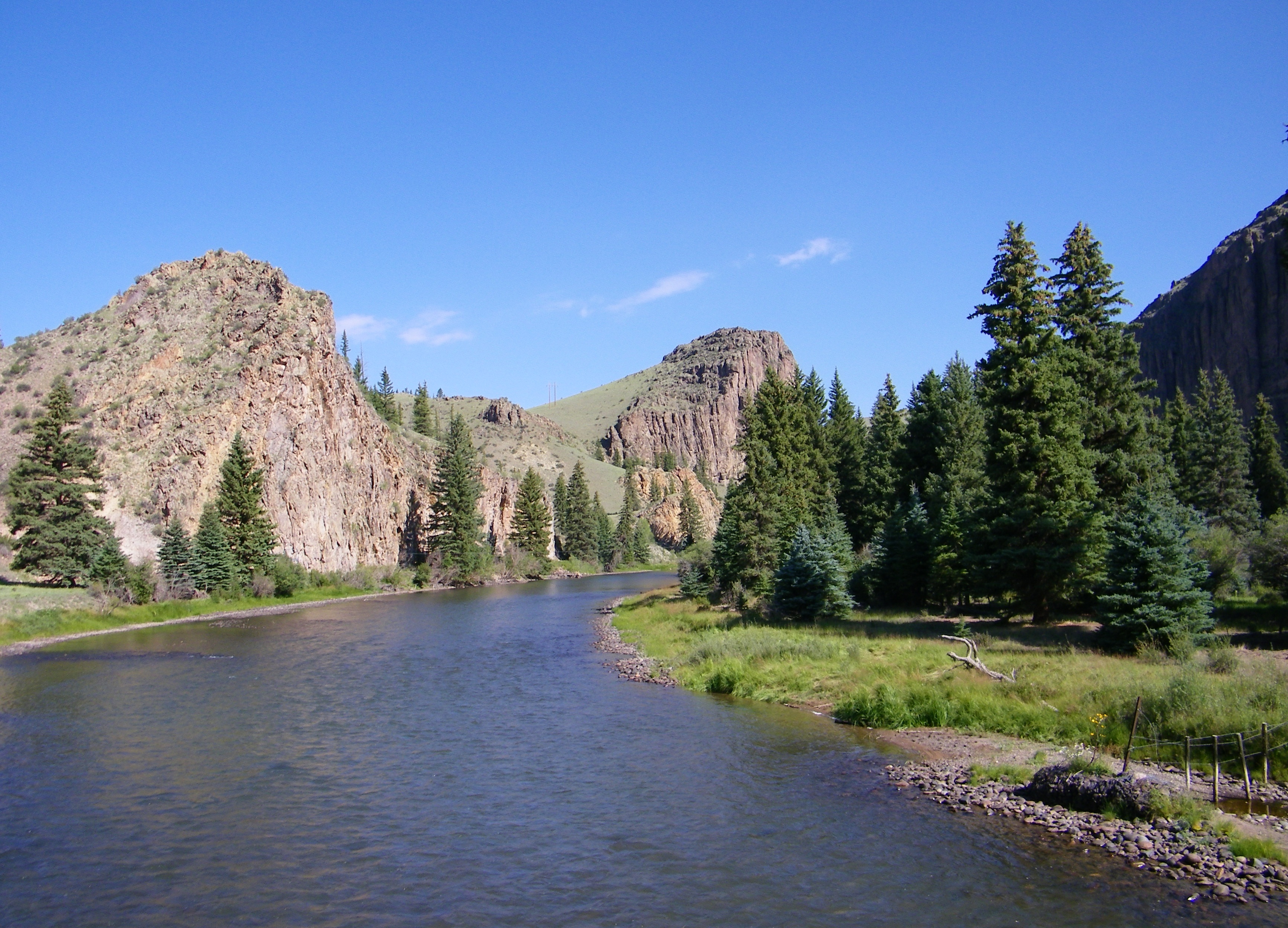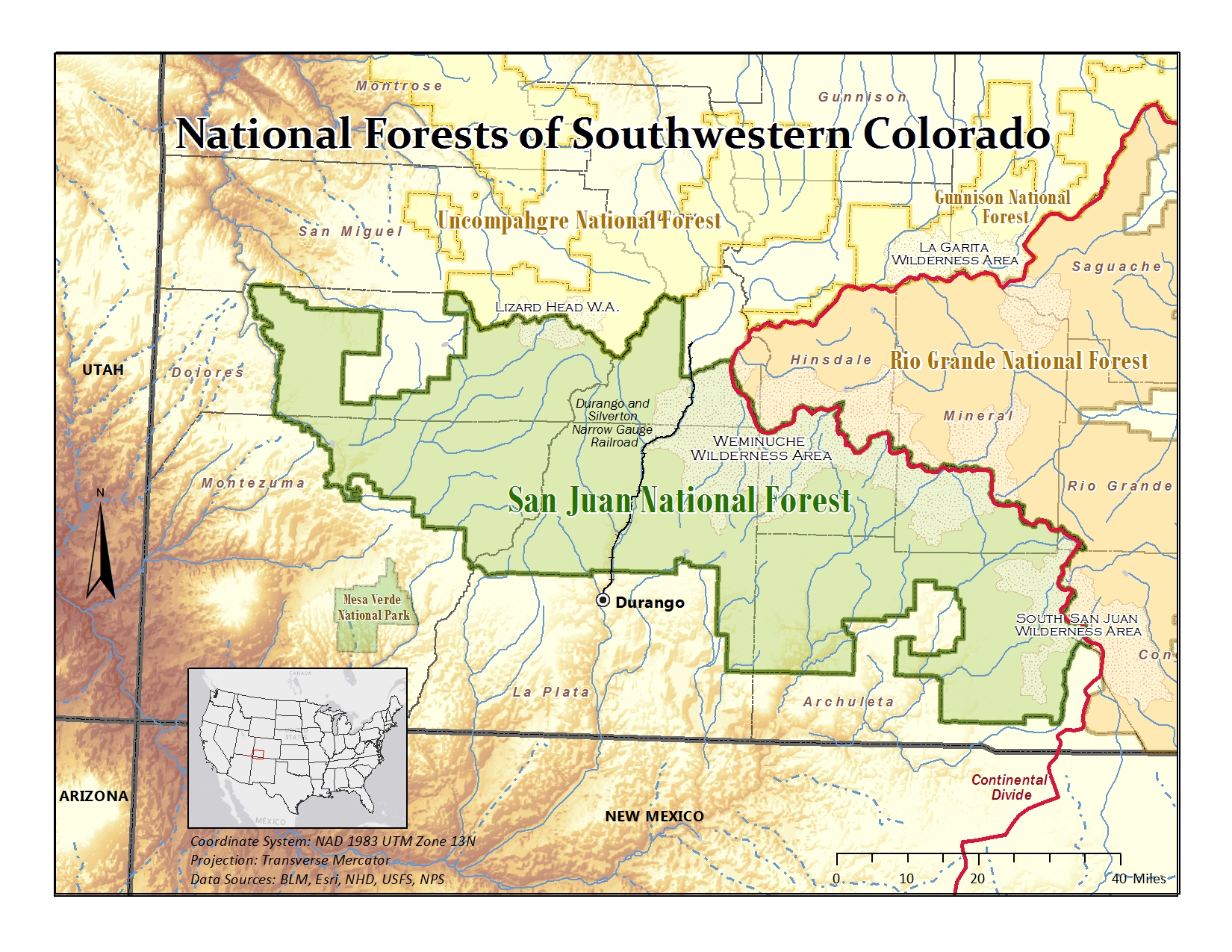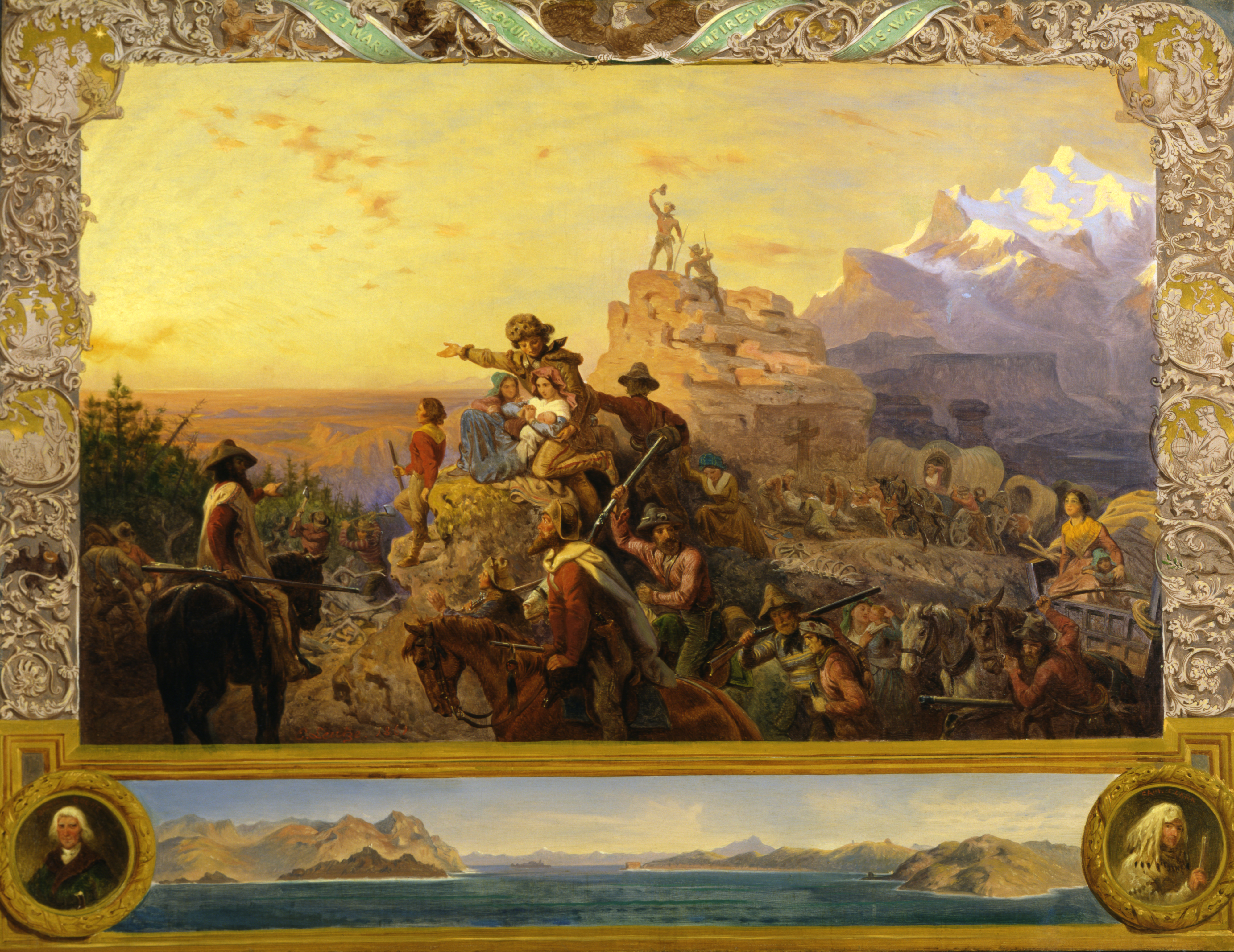|
Mineral County, Colorado
Mineral County is a county located in the U.S. state of Colorado. As of the 2020 census, the population was 865, making it the third-least populous county in Colorado, behind San Juan County and Hinsdale County. The county seat and only incorporated municipality in the county is Creede. The county was named for the many valuable minerals found in the mountains and streams of the area. Geography According to the U.S. Census Bureau, the county has a total area of , of which is land and (0.2%) is water. Adjacent counties * Saguache County - northeast * Rio Grande County - east * Archuleta County - south * Hinsdale County - west Major Highways * U.S. Highway 160 * State Highway 149 National protected areas *Rio Grande National Forest *San Juan National Forest * La Garita Wilderness *Weminuche Wilderness Trails and byways * Colorado Trail * Continental Divide National Scenic Trail * Lake Fork National Recreation Trail * Silver Thread Scenic Byway Demographics At ... [...More Info...] [...Related Items...] OR: [Wikipedia] [Google] [Baidu] |
Rio Grande Below Creede CO
Rio or Río is the Portuguese, Spanish, Italian, and Maltese word for "river". When spoken on its own, the word often means Rio de Janeiro, a major city in Brazil. Rio or Río may also refer to: Geography Brazil * Rio de Janeiro * Rio do Sul, a town in the state of Santa Catarina, Brazil Mexico * Río Bec, a Mayan archaeological site in Mexico * Río Bravo, Tamaulipas, a city in Mexico United States * Rio, a location in Deerpark, New York, US * Rio, Florida, a census-designated place in Martin County, US * Rio, Georgia, an unincorporated community in Spalding County, US * Rio, Illinois, a village in Knox County, US * Rio, Virginia, a community in Albemarle County, US * Rio, West Virginia, a village in Hampshire County, US * Rio, Wisconsin, a village in Columbia County, US * El Río, Las Piedras, Puerto Rico, a barrio * Río Arriba, Añasco, Puerto Rico, a barrio * Río Arriba, Arecibo, Puerto Rico, a barrio * Río Arriba, Fajardo, Puerto Rico, a barrio * Río Arriba, Vega Baja ... [...More Info...] [...Related Items...] OR: [Wikipedia] [Google] [Baidu] |
San Juan National Forest
The San Juan National Forest is a U.S. National Forest covering over 1,878,846 acres (2,935.7 sq mi, or 7,603.42 km²) in western Colorado. The forest occupies land in Archuleta, Conejos, Dolores, Hinsdale, La Plata, Mineral, Montezuma, Rio Grande, San Miguel and San Juan Counties. It borders the Uncompahgre National Forest to the north and the Rio Grande National Forest to the east. The forest covers most of the southern portion of the San Juan Mountains west of the Continental Divide. The forest contains two alpine wilderness areas; the Weminuche and South San Juan, as well as the Piedra Area. The Durango and Silverton Narrow Gauge Railroad passes through the National Forest. The name of the forest comes from the San Juan River, which was originally called the Rio San Juan, after Saint John the Baptist (San Juan Bautista in Spanish). History Theodore Roosevelt created the forest by proclamation on June 3, 1905. Forest headquarters are located in Dur ... [...More Info...] [...Related Items...] OR: [Wikipedia] [Google] [Baidu] |
American Ancestry
American ancestry refers to people in the United States who self-identify their ancestral origin or descent as "American," rather than the more common officially recognized racial and ethnic groups that make up the bulk of the American people. The majority of these respondents are visibly White Americans, who either simply use this response as a political statement or are far removed from and no longer self-identify with their original ethnic ancestral origins. The latter response is attributed to a multitude of generational distance from ancestral lineages, and these tend be Anglo Americans of Scotch-Irish, English, or other British ancestries, as demographers have observed that those ancestries tend to be recently undercounted in U.S. Census Bureau American Community Survey ancestry self-reporting estimates. Although U.S. Census data indicates "American ancestry" is most commonly self-reported in the Deep South, the Upland South, and Appalachia, a far greater number of ... [...More Info...] [...Related Items...] OR: [Wikipedia] [Google] [Baidu] |
Irish Americans
, image = Irish ancestry in the USA 2018; Where Irish eyes are Smiling.png , image_caption = Irish Americans, % of population by state , caption = Notable Irish Americans , population = 36,115,472 (10.9%) alone or in combination 10,899,442 (3.3%) Irish alone 33,618,500(10.1%) alone or in combination 9,919,263 (3.0%) Irish alone , popplace = Boston New York City Scranton Philadelphia New Orleans Pittsburgh Cleveland Chicago Baltimore Detroit Milwaukee Louisville New England Delaware Valley Coal Region Los Angeles Las Vegas Atlanta Sacramento San Diego Houston Dallas San Francisco Palm Springs, California Fairbanks and most urban areas , langs = English ( American English dialects); a scant speak Irish , rels = Protestant (51%) Catholic (36%) Other (3%) No religion (10%) (2006) , related = Anglo-Irish people Breton Americans Cornish Americans English Americans I ... [...More Info...] [...Related Items...] OR: [Wikipedia] [Google] [Baidu] |
German Americans
German Americans (german: Deutschamerikaner, ) are Americans who have full or partial German ancestry. With an estimated size of approximately 43 million in 2019, German Americans are the largest of the self-reported ancestry groups by the United States Census Bureau in its American Community Survey. German Americans account for about one third of the total population of people of German ancestry in the world. Very few of the German states had colonies in the new world. In the 1670s, the first significant groups of German immigrants arrived in the British colonies, settling primarily in Pennsylvania, New York and Virginia. The Mississippi Company of France moved thousands of Germans from Europe to Louisiana and to the German Coast, Orleans Territory between 1718 and 1750. Immigration ramped up sharply during the 19th century. There is a "German belt" that extends all the way across the United States, from eastern Pennsylvania to the Oregon coast. Pennsylvania, with 3.5 millio ... [...More Info...] [...Related Items...] OR: [Wikipedia] [Google] [Baidu] |
English Americans
English Americans (historically known as Anglo-Americans) are Americans whose ancestry originates wholly or partly in England. In the 2020 American Community Survey, 25.21 million self-identified as being of English origin. The term is distinct from British Americans, which includes not only English Americans but also Scottish, Scotch-Irish (descendents of Ulster Scots from Ulster, Ireland), Welsh, Cornish and Manx Americans from the whole of the United Kingdom. Demographers regard the reported number of English Americans as a serious undercount, as the index of inconsistency is high and many if not most Americans of English ancestry have a tendency to identify simply as "Americans" or if of mixed European ancestry, identify with a more recent and differentiated ethnic group. In the 1980 census, 49.6 million Americans claimed English ancestry. At 26.34%, this was the largest group amongst the 188 million people who reported at least one ancestry. The population was 22 ... [...More Info...] [...Related Items...] OR: [Wikipedia] [Google] [Baidu] |
Poverty Line
The poverty threshold, poverty limit, poverty line or breadline is the minimum level of income deemed adequate in a particular country. The poverty line is usually calculated by estimating the total cost of one year's worth of necessities for the average adult.Poverty Lines – Martin Ravallion, in The New Palgrave Dictionary of Economics, 2nd Edition, London: Palgrave Macmillan The cost of housing, such as the rent for an apartment, usually makes up the largest proportion of this estimate, so economists track the real estate market and other housing cost indicators as a major influence on the poverty line. Individual factors are often used to account for various circumstances, such as whether one is a parent, elderly, a child, married, etc. The poverty threshold may be adjusted annually. In practice, like the definition of poverty, the official or common understanding of the poverty line is significantly higher in developed countries than in developing countries. In October ... [...More Info...] [...Related Items...] OR: [Wikipedia] [Google] [Baidu] |
Race And Ethnicity In The United States Census
Race and ethnicity in the United States census, defined by the federal Office of Management and Budget (OMB) and the United States Census Bureau, are the self-identified categories of race or races and ethnicity chosen by residents, with which they most closely identify, and indicate whether they are of Hispanic or Latino origin (the only categories for ethnicity). The racial categories represent a social-political construct for the race or races that respondents consider themselves to be and, "generally reflect a social definition of race recognized in this country." OMB defines the concept of race as outlined for the U.S. census as not "scientific or anthropological" and takes into account "social and cultural characteristics as well as ancestry", using "appropriate scientific methodologies" that are not "primarily biological or genetic in reference." The race categories include both racial and national-origin groups. Race and ethnicity are considered separate and disti ... [...More Info...] [...Related Items...] OR: [Wikipedia] [Google] [Baidu] |
2000 United States Census
The United States census of 2000, conducted by the Census Bureau, determined the resident population of the United States on April 1, 2000, to be 281,421,906, an increase of 13.2 percent over the 248,709,873 people enumerated during the 1990 census. This was the twenty-second federal census and was at the time the largest civilly administered peacetime effort in the United States. Approximately 16 percent of households received a "long form" of the 2000 census, which contained over 100 questions. Full documentation on the 2000 census, including census forms and a procedural history, is available from the Integrated Public Use Microdata Series. This was the first census in which a state – California – recorded a population of over 30 million, as well as the first in which two states – California and Texas – recorded populations of more than 20 million. Data availability Microdata from the 2000 census is freely available through the Integrated Public Use Microdata Seri ... [...More Info...] [...Related Items...] OR: [Wikipedia] [Google] [Baidu] |
Silver Thread Scenic Byway
Silver is a chemical element with the symbol Ag (from the Latin ', derived from the Proto-Indo-European ''h₂erǵ'': "shiny" or "white") and atomic number 47. A soft, white, lustrous transition metal, it exhibits the highest electrical conductivity, thermal conductivity, and reflectivity of any metal. The metal is found in the Earth's crust in the pure, free elemental form ("native silver"), as an alloy with gold and other metals, and in minerals such as argentite and chlorargyrite. Most silver is produced as a byproduct of copper, gold, lead, and zinc refining. Silver has long been valued as a precious metal. Silver metal is used in many bullion coins, sometimes alongside gold: while it is more abundant than gold, it is much less abundant as a native metal. Its purity is typically measured on a per-mille basis; a 94%-pure alloy is described as "0.940 fine". As one of the seven metals of antiquity, silver has had an enduring role in most human cultures. Other than i ... [...More Info...] [...Related Items...] OR: [Wikipedia] [Google] [Baidu] |








